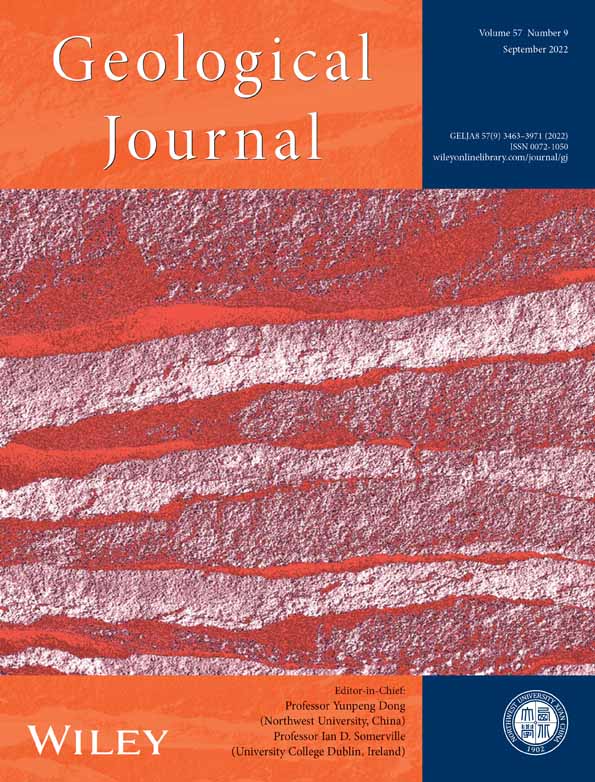Deformation history of the Feidong Segment of the Tan–Lu Fault zone in the Early Cretaceous: Implications for the tectonic evolution in eastern China
Funding information: Public Geological Survey Program of Anhui Province, Grant/Award Number: 2016–g–1–4; China Geological Survey, Grant/Award Number: DD20190043
Abstract
The Tan–Lu Fault zone (TLFZ) is the largest fault zone in eastern China and a typical and representative structure of the Circum–Pacific tectonic domain. The Late Mesozoic tectonic evolution of the TLFZ is greatly significant, since it revealed the Jurassic–Cretaceous tectonic evolution of eastern China and the subduction history of the Palaeo–Pacific Plate. However, its tectonic evolution in the Early Cretaceous remains controversial. Based on geological mapping, microstructural analysis, and LA–ICP–MS zircon U–Pb dating, we constrained the deformation history of the Feidong Segment of the TLFZ in the Early Cretaceous. Results showed that the Feidong Segment of the TLFZ experienced a strong sinistral strike–slip movement at the beginning of the Early Cretaceous (~143 Ma); it was subsequently subjected to normal faulting during the Early Cretaceous (135–102 Ma), which controlled the strong magmatic activities within the Feidong area. At the end of the Early Cretaceous (~100 Ma), a weak sinistral strike–slip movement occurred again along the TLFZ. The deformation temperatures of the two sinistral strike–slip shearing stages were 500–550°C and 400–450°C, respectively. The regional comparison indicated that the Early Cretaceous tectonic evolution of the TLFZ was actually the epitome of the contemporaneous tectonic evolution of eastern China and was the result of strain localization in the Cretaceous tectonic framework of eastern China.
1 INTRODUCTION
It is widely accepted that the Jurassic–Cretaceous tectonics in eastern China were controlled by the subduction of the Palaeo–Pacific Plate (Xu, Zhu, Tong, Cui, & Liu, 1987; Zhao, Cui, Guo, & Xu, 2002; Li & Li, 2007; Dong et al., 2008, 2015, 2019; Zhu, Jiang, Zhang, & Chen, 2012, Zhu et al., 2012, Zhu et al., 2017; Li et al., 2017, 2018, 2019, Li et al., 2021; Zhu & Yigang, 2019; Yin, Zhu, Wu, Su, & Zhang, 2020; Yuan et al., 2020; Figure 1a). Regional extension and compression events have been widely reported in both the North China Craton (NCC) (Dong et al., 2015; Gu et al., 2017; Liu et al., 2018; Wang et al., 2011; Zhang et al., 2019; Zhu et al., 2018) and South China Block (SCB) (Chu et al., 2019; Chu, Lin, Faure, Allen, & Feng, 2020; Li et al., 2013; Li et al., 2020; Li et al., 2020; Li, Zhang, Dong, & Johnston, 2014; Shu et al., 2009). However, the tectonic evolution process is still disputable, particularly with respect to the exact timing of different compressional and extensional events (Su et al., 2021; Zhang et al., 2020).
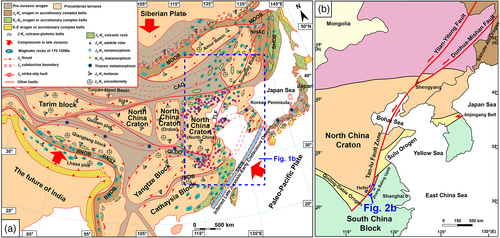
The large fault zone is a weak zone in the lithosphere; it is very sensitive to regional tectonic movement and is the best record of the regional dynamic evolutionary history (Zhu et al., 2018). The NNE–trending Tan–Lu Fault zone (TLFZ) is the largest strike–slip fault at the East Asian continental margin (Xu, Wang, Ching, & Ye, 1986; Xu et al., 1987; Xu, Ma, Tong, Zhu, & Lin, 1993; Song, Zhu, Liu, Niu, & Liu, 2003; Zhu et al., 2004, 2005, 2009, 2018; Li, Cawood, et al., 2020, Li, Song, et al., 2020; Figure 1b). Its Late Mesozoic deformation history depicts the Jurassic–Cretaceous tectonic evolution of eastern China. It is generally considered that the TLFZ formed during the collision between the NCC and SCB in the Middle to Late Triassic (Chung, 1999; Gilder et al., 1999; Li, 1994; Li et al., 2017; Lin & Li, 1995; Okay & Şengör, 1992; Yin & Nie, 1993; Zhang, Christian, Jim, & Zhu, 2007; Zhao, Zhu, Lin, & Wang, 2016; Zhu et al., 2009). However, the Late Mesozoic tectonic evolution of the TLFZ remains controversial.
Based on fault–slip data along the middle part of the fault zone, Zhang, Dong, and Shi (2003) inferred that the fault zone experienced dextral, normal, and sinistral faulting from an earlier to a later stage of the Early Cretaceous. Some researchers have suggested that the TLFZ fault zone was involved in dextral strike–slip and normal faulting in the Early Cretaceous, while the kinematic transition occurred at ~120 Ma (Zhang, Dong, & Shi, 2003; Zhang & Dong, 2008). Zhang, Mao, Zhang, and Wilde (2008) proposed that the TLFZ experienced a three-stage evolution, that is, sinistral strike–slip movement from the end of the Late Jurassic to the beginning of the Early Cretaceous, extensional activities, and normal faulting in the Early Cretaceous, and dextral strike–slip movement from the Late Cretaceous to the Palaeocene. However, others have argued that the strike–slip movement and extensional activity occurred alternately in the TLFZ during the Late Mesozoic, which can be specifically divided into sinistral strike–slip movement at the end of the Middle Jurassic and the beginning of the Early Cretaceous, extensional activities during the Early Cretaceous, sinistral strike–slip movement at the end of the Early Cretaceous, and extensional activities in the Late Cretaceous (Zhang, Dong, & Shi, 2003; Wang, 2006; Mercier, Hou, Vergély, & Wang, 2007; Gu et al., 2017; Zhang et al., 2018; Zhu et al., 2005, 2018; Zhu, Niu, Xie, & Wang, 2010). The above review suggests that the tectonic evolution of the TLFZ remains unclear, with the most controversial period being the Early Cretaceous.
The Feidong area in the southern segment of the Zhangbaling Uplift is among the best-exposed regions of ductile shear zones in the entire TLFZ (Lin, Faure, Wang, Monie, & Panis, 2005; Zhang, Giorgis, & Teyssier, 2013), and depicts the TLFZ deformation history. In this study, we conducted field-based structural investigations combined with microstructural analysis and geochronological studies of the Feidong Segment of the TLFZ. Two stages of sinistral strike-slip activity were identified in this segment. The deformation ages and the Early Cretaceous tectonic evolution of the Feidong Segment of the TLFZ were constrained. Based on previous studies on regional tectonics, we discuss the Cretaceous tectonic evolution of eastern China and its geodynamic mechanisms.
2 GEOLOGICAL SETTING
The TLFZ is a major fault zone of a series of NE–trending giant fault systems on the East Asian continent (Dong et al., 2008, 2015, 2019; Xu et al., 1987; Zhu et al., 2018). It starts from Wuxue in Hubei Province on the north bank of the Yangtze River in the south and goes through Anhui, Jiangsu, Shandong Provinces, and the Bohai Sea. After passing Shenyang, the TLFZ is divided into the Yilan–Yitong Fault zone in the west branch and the Mishan–Fushun Fault zone in the east branch; it generally extends to the far east of Russia in a slow S–shape, with a length of 2400 km within China (Figure 1b).
Previous studies have shown that the TLFZ formed as a syn–collisional sinistral strike–slip fault resulting from the collision between the NCC and SCB in the Middle to Late Triassic (Watson, Hayward, & Parkingson, 1987; Xu et al., 1987; Xu et al., 1993; Yin & Nie, 1993; Li, 1994; Chang, 1996; Zhang, 1997; Xiao, Zhou, Yang, & Zhao, 2000; Tang, Li, & Lou, 2003; Mercier et al., 2007; Zhu et al., 2004, 2009; Zhao et al., 2016). Subsequently, the TLFZ was reactivated by the subduction of the Palaeo–Pacific Plate at the end of the Middle Jurassic and experienced multistage evolution during the Late Mesozoic (Li, Cawood, et al., 2020; Li, Song, et al., 2020; Zhu et al., 2005; Zhu et al., 2010; Zhu et al., 2018; Zhu, Jiang, et al., 2012). In the Palaeogene–Neogene, the fault zone exhibited intense extensional activity, which controlled the development of faulted basins and the eruption of basalt (Niu, Zhu, Liu, Song, & Wang, 2005; Ren, Tamaki, Li, & Zhang, 2002; Zhu, Jiang, et al., 2012; Zhu, Xu, et al., 2012). During the Quaternary, the fault zone presented a dextral–slip thrust fault and became a strong seismic zone in eastern China (Liu, Zhu, Hu, & Song, 2015).
The Zhangbaling Uplift is mainly distributed in an NNE direction between the Dabie and Sulu orogenic belts, with the Lower Yangtze foreland fold and thrust belt to the east and the Hefei Basin at the NCC to the west. The Feidong Complex is located in the southern section of the Zhangbaling Uplift. It has generally undergone medium–high amphibolite-facies metamorphism and varying degrees of migmatisation (Shi, Zhu, & Wang, 2009; Zhang et al., 2007), and mainly consists of biotite plagioclase gneiss, hornblende plagioclase gneiss, amphibolite, dolomite marble, and mica schist. Based on the lithological combination, the Feidong Complex was divided into the Noearchean Fuchashan, Palaeoproterozoic Dahengshan, Mesoproterozoic Shuangshan, and Qiaotouji formations, as well as some metamorphic and deformed intrusive rocks (Anhui Bureau of Geology and Mineral Resources, 1987).
Previous research has demonstrated that the TLFZ comes through the entire Zhangbaling Uplift and results in strong deformation (Song et al., 2003; Xu et al., 1987; Zhu et al., 2005). Several NNE–trending basement sinistral strike–slip ductile shear zones have been found in the Fucha Mountains in the Feidong area (Zhu et al., 2005). The kinematic vorticity values of 0.87–0.95 indicated that the deformation of the ductile shear zones is mainly simple shear, with a pure shear component (Wang et al., 2006). Mylonites developed under the middle to upper greenschist facies conditions, with deformation temperatures of ca. 400–500°C (Wang et al., 2006; Wang et al., 2016; Wang, Niu, Wu, Han, & Li, 2016; Wang, Yang, Wang, & Yu, 2016; Zhu et al., 2005).
Recently, a large amount of geochronological data have been documented, including 40Ar–39 Ar ages of hornblende, biotite, muscovite, and whole-rock age of mylonite, as well as zircon U–Pb ages of deformed dikes, and intrusions (Figure 2; Zhu et al., 2005, 2010, 2018; Han et al., 2015; Wang et al., 2015; Li, Cawood, et al., 2020, Li, Song, et al., 2020), indicating that the sinistral strike–slip movement of the TLFZ may have occurred in the Early Cretaceous. Subsequently, the TLFZ was involved in an intense extension, and a series of intermediate–acid magmatic rocks with ages of 127–102 Ma were emplaced along the Feidong Segment (Niu et al., 2008; Zhu et al., 2010).
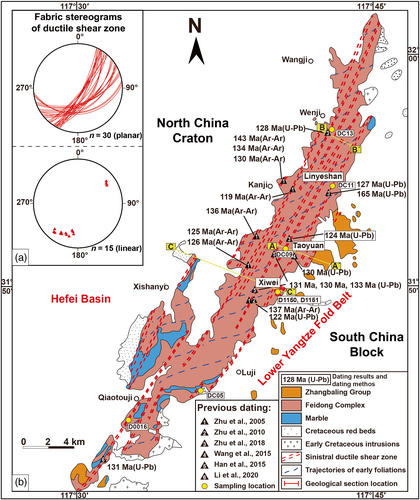
3 DEFORMATION CHARACTERISTICS OF THE FEIDONG STRIKE–SLIP DUCTILE SHEAR ZONE
The Feidong shear zone in the southern segment of the Zhangbaling Uplift is an important feature. Previous studies have confirmed that this is a composite shear zone, that is, composed of several NNE–striking shear zones (Han et al., 2015; Wang, Niu, et al., 2016, Wang, Song, et al., 2016, Wang, Yang, et al., 2016; Zhu et al., 2005, 2010, 2016, Zhu et al., 2018; Li, Cawood, et al., 2020, Li, Song, et al., 2020; Figure 2). In this study, we identified several nearly parallel ductile shear zones through detailed geological mapping in the Feidong area (Figure 2) and performed detailed geometric and kinematic analyses.
3.1 Field characteristics of the strike–slip ductile shear zones
3.1.1 The Taoyuan strike–slip ductile shear zone
The Taoyuan strike–slip ductile shear zone is located in the Taoyuan area with an exposed area of approximately 200 m2 (Figure 2). The shear zone that developed in the Feidong Complex led to intense mylonitisation of amphibolites and hornblende plagioclase gneiss (Figure 3b). Two episodes of shear deformation (D1 and D2) are evident in this shear zone. The D1 deformation is characterized by penetrative mylonitic foliations (S1), which dominantly strike N30° E and dip steeply toward ESE (Figure 3a). A conspicuous mineral stretching lineation (L1) is evident on the S1 surface. The lineation is clearly defined by the orientation of biotite and hornblende or elongated fragments, which plunge shallowly at 10–25° SSW (Figure 3a).
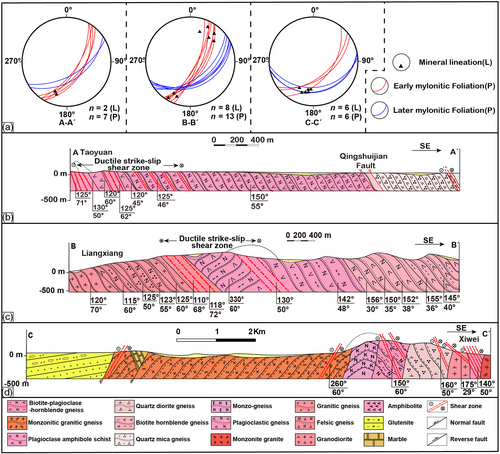
After the early sinistral strike–slip event, another ductile deformation (D2) occurred. It is clearly evident that a pegmatite dike intruded the earlier shear zone and cut through the S1 foliations. However, after the dike emplacement, the sinistral strike–slip activity was superimposed again, thereby causing the dike in the latter shear zone to be shear–deformed; nevertheless, outside the latter shear zone, it was not involved in deformation (Figure 4a). In addition, the early mylonitic foliation (S1) was refolded, dragged, or offset in the D2 deformation, as well as in the sinistral shear sense. In contrast, the pegmatite dike deformed in the late shear zone was not involved in the fold (Figure 4b). On the stereographic projection of deformation fabrics, S2 foliations dominantly strike 45–55° NE and have dips of 65–70° SE, which are different from S1 foliations (Figure 3a). The asymmetric folds, S–C fabrics, and rotational feldspar porphyroblasts (Figure 4c) on the outcrop indicate a sinistral shear sense of the early shear event.
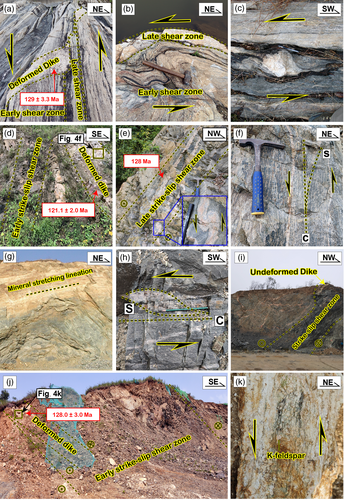
3.1.2 The Wenji strike–slip ductile shear zone
The Wenji strike–slip ductile shear zone is located south-east of the Wenji area in the northern part of the Feidong Complex (Figure 2), with an exposed width of approximately 100 m. The protolith in the shear zone is the orthogneiss of the Feidong Complex, consisting mainly of granitic gneiss and biotite plagiogneiss (Figure 3c). Two episodes of shear deformation (D1 and D2) are also evident in this shear zone. The mylonitic foliation (S1) in the shear zone strikes N20–40° E and dips 50–72° SE, with mineral stretching lineation plunging gently toward the NE or SW (Figure 3a). Dikes intruded in the ductile shear zone, obliquely intersecting the strike of the mylonitic foliation at a 30° angle (Figures 4d); however, these dikes also underwent ductile deformation, with mylonitic foliation (S2) dominantly striking N60° E and dipping 75° SE. The asymmetric fold (Figure 4f) and S–C fabric (Figure 4e) in the dikes indicate a sinistral strike–slip shear sense of the latter shear zone. All this evidence suggests that there are two-stage shear deformations in the Wenji area.
3.1.3 The Xiwei strike–slip ductile shear zone
The Xiwei strike–slip ductile shear zone is located on the south-eastern foot of the Fucha Mountain, approximately 5 km south-west of the Taoyuan ductile shear zone (Figure 2). The metamorphic complexes in the shear zone are highly deformed into mylonites and even ultramylonite. The mylonitic foliations (S1) dominantly strike N35 °E and have dips of 60–80° SE (Figure 3a,d). Mineral stretching lineations (L1) are defined by aligned biotite and hornblende, and generally gently plunge at 10–20° SW (Figures 3a and 4g). The S–C fabric in the outcrop indicates a sinistral shear sense (Figure 4h). Many granitic dikes intrude into the shear zone. Most are undeformed and cut the early mylonitic foliation (Figure 4i); however, a few of them have experienced ductile deformation, indicating that there was another ductile deformation event (D2) after the dike emplacement. The S2 foliations plunge 29–175° on average (Figure 3a), which is obviously different from the S1 foliations.
3.1.4 The Linyeshan strike–slip ductile shear zone
The Linyeshan strike–slip ductile shear zone is located on the Linyeshan iron mine slope in the north of the Qingjian Village in the middle of the Feidong Complex (Figure 2), and with approximately 100 m in width. Similar to the other three shear zones, two episodes of shear deformation (D1 and D2) are also evident in this shear zone (Figure 4j). The mylonitic foliation (S1) plunges on average 68–145° SE, with nearly horizontal mineral stretching lineations evident at the surface. Deformed pegmatite dikes that intruded the shear zone and obliquely cut the S1 foliation are also evident in the shear zone. The S2 foliations predominantly strike N45° E and dip 50° SE. The rotated K–feldspar porphyroclasts in the deformed pegmatite dikes suggest a sinistral sense of shear in the latter shear zone (Figure 4k).
Overall, field observations of the four strike–slip ductile shear zones indicate that there are two periods of the sinistral strike–slip movement (D1 and D2) that occurred in the Feidong Segment of the TLFZ: D1 was characterized by highly penetrative mylonitic foliation (S1), which is best expressed in metamorphic complexes. S1 dominantly dips SE at a steep angle of 60–85° and L1 generally plunges SSW; however, the late sinistral strike–slip events (D2) formed alternating NE–trending ductile and heterogeneous ductile deformations. Thus, it is evident that the intrusive rocks and dikes were undeformed in the early shear zones and that the dikes were mylonitized in the latter shear zones. Contrary to S1, S2 typically dips SSE at a moderate angle of 30–50° (Figure 3a).
3.2 Microstructure and deformation temperature of the shear zone
The deformation behaviour of minerals in mylonite corresponds well with the deformation temperature; therefore, this deformation behaviour can be used for estimating the deformation temperature. Previous studies have shown that the deformation temperatures of bulging (BLG), subgrain rotation (SR), and grain boundary migration (GBM) recrystallizations of quartz are 300–400, 400–500, and >500°C, respectively (Passchier & Trouw, 2005; Stipp, Stünitz, Heilbronner, & Schmid, 2002; Tullis & Yund, 1991). Furthermore, the brittle fracturing and cataclastic flow, plastic elongation, and dynamic recrystallization of feldspar correspond to the deformation temperatures of 300–400, 400–500, and >500°C, respectively (Mancktelow & Pennacchioni, 2004; Passchier & Trouw, 2005; Stipp et al., 2002). Therefore, we collected oriented specimens of mylonites within the Feidong strike–slip ductile shear zones and performed microstructural analysis. The deformation temperature was estimated based on the mineral deformation behaviour of quartz and feldspar in mylonite. The mineral assemblage, deformation behaviour, and deformation temperature of the mylonite samples are presented in Table 1.
| Sample no. | Location | Protolith | Rock type | Mineral assemblage | Quartz recrystallization | Feldspar deformation | Estimated T(°C) |
|---|---|---|---|---|---|---|---|
| DC9-1 | Taoyuan | Biotite plagioclase gneiss | Mylonite | P (35%): Pl + Qtz + Bt M (65%): Pl + Qtz + Bt + Ch | GBM | Elongated | 500–550°C |
| DC9-2 | Taoyuan | Monzogranite dike | Mylonite | P (35%): Pl + Qtz M (65%): Pl + Qtz + Bt | GBM | Fractured | 400–450°C |
| DC13-1 | Wenji | Biotite plagioclase gneiss | Mylonite | P (10%): Pl + Qtz + Bt M (90%): Pl + Qtz + Bt + Ch | SR | Elongated | 500–550°C |
| DC13-3 | Wenji | Monzogranite dike | Mylonite | P (40%): Pl + Qtz M (60%): Pl + Qtz + Bt | SR | Fractured | 400–450°C |
| D1150 | Xiwei | Biotite plagioclase gneiss | Ultramylonite | P (35%): Pl + Qtz M (65%): Pl + Qtz + Bt | GBM | Elongated | 500–550°C |
| D1151 | Xiwei | Granite dike | Protomylonite | P (10%): Pl + Qtz M (90%): Pl + Qtz + Bt | SR | Fractured | 400–450°C |
| DC11-1 | Linyeshan | Plagioclase hornblende gneiss | Mylonite | P (40%): Pl + Qtz + Hb M (60%): Pl + Qtz + Bt | GBM | Elongated | 500–550°C |
| DC11 | Linyeshan | Granite pegmatite dike | Mylonite | P (40%): Pl + Qtz M (60%): Pl + Qtz + Bt | SR | Elongated | 400–450°C |
Microscopic shear sense indicators, such as porphyroclast systems (Figure 5a–h), S–C fabric (Figure 5b–d,h), and domino–type fragmented porphyroclast (Figure 5f) in mylonites or mylonitic dikes indicate that the two ductile shear events all exhibit a sinistral shear sense.
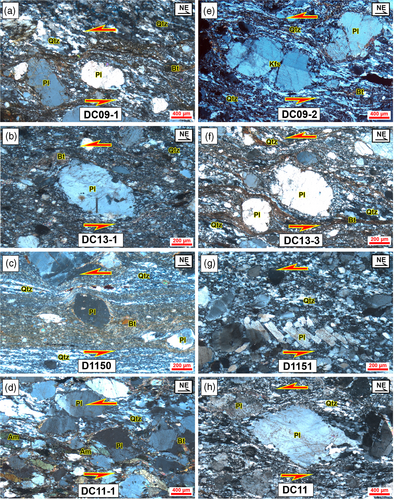
Samples DC09–1, DC13–1, D1150, and DC11–1 were mylonite or ultramylonite, and were collected from the early shear zone associated with the D1 event. Their porphyroclasts were mainly plagioclase, and occasionally hornblende. The matrices were fine-grained, recrystallized quartz, biotite, and hornblende (Figure 5a–d). Quartz in these samples predominantly exhibited grain boundary migration (GBM) (Figure 5a,c–d) and subgrain rotation (SR) (Figure 5b) recrystallizations. Plagioclases mostly exhibited plastic elongation with partial recrystallization. These microstructures indicated that the deformation temperature of the early strike–slip ductile shear zones was concentrated in the 500–550°C range (Table 1).
In contrast, the four mylonite samples DC09–2, DC13–3, D1151, and DC11 were collected from the latter shear zone associated with the D2 event. Almost all porphyroclasts in the four mylonites were plagioclase or K–feldspar (Figure 5e–h). The matrices were predominantly fine-grained, recrystallized quartz, with minor biotite and muscovite (Figure 5e–h). The feldspars mostly exhibited brittle fracturing and cataclastic flow, except for sample DC11 (Figure 5e–g), in which plastic elongation was evident (Figure 5h). In the matrices, quartz presented evidence of subgrain rotation (SR) (Figure 5f–h) and grain boundary migration (GBM) (Figure 5e) recrystallizations. Based on these temperature indicators, the deformation temperatures for mylonites from the latter shear zone were estimated at 400–450°C.
4 ZIRCON U–Pb DATING
Magmatic activity occurred frequently in the Feidong area of the TLFZ during the Late Mesozoic (Niu et al., 2008; Shang, Yan, Song, Liu, & Li, 2018). Magmatic rocks are mostly intermediate–acid intrusive rocks and pegmatite dikes, which are closely related to the extension and shearing of the TLFZ and can constrain well its tectonic evolution. Therefore, five samples of deformed dikes and undeformed intrusive rocks were systematically collected for laser ablation inductively coupled plasma mass spectrometry (LA–ICP–MS) zircon U–Pb dating to assess the protolith ages and timing of shear deformation in the Feidong area (Table 2). The sampling locations are shown in Figure 2.
| Localities | Sample no. | Rock type | Method | Age/Ma | Data sources |
|---|---|---|---|---|---|
| Taoyuan, Feidong | FA1 | Ultramylonite | Zircon U–Pb | 133.3 ± 4.1 | Wang et al. (2015) |
| Taoyuan, Feidong | YT21 | Deformed pegmatite dike | Zircon U–Pb | 129.0 ± 3.3 | Wang, Niu, et al. (2016), Wang, Song, et al. (2016), Wang, Yang, et al. (2016) |
| Taoyuan, Feidong | FA7 | Mylonite | Zircon U–Pb | 124.0 ± 3.6 | Wang, Niu, et al. (2016), Wang, Song, et al. (2016), Wang, Yang, et al. (2016) |
| Taoyuan, Feidong | XW-3 | Mylonitized granite dike | Zircon U–Pb | 133.2 ± 1.9 | Han et al. (2015) |
| Xiwei, Chaohu | TY-7 | Mylonitized granite pegmatite dike | Zircon U–Pb | 131.3 ± 2.0 | Han et al. (2015) |
| Xiwei, Chaohu | TY-8 | Mylonitized granite fine crystal dike | Zircon U–Pb | 130.3 ± 2.0 | Han et al. (2015) |
| Malongshan, Feidong | SK002-3A | Mylonitized granite pegmatite dike | Zircon U–Pb | 130.9 ± 3.6 | Li, Cawood, et al. (2020), Li, Song, et al. (2020) |
| Xieji, Feidong | FD12 | Deformed granite dike | Zircon U–Pb | 127.8 ± 2.0 | Zhu et al. (2018) |
| Xieji, Feidong | FD13-1 | Deformed granite dike | Zircon U–Pb | 131.5 ± 4.1 | Zhu et al. (2018) |
| Xieji, Feidong | FD13-2 | Deformed diorite dike | Zircon U–Pb | 133.7 ± 1.8 | Zhu et al. (2018) |
| Yantoushan, Chaohu | FD7-2 | Deformed diorite dike | Zircon U–Pb | 126.8 ± 2.0 | Zhu et al. (2018) |
| Zhaishan, Chaohu | FD5 | Deformed granite dike | Zircon U–Pb | 123.5 ± 2.1 | Zhu et al. (2018) |
| Xiwei, Chaohu | D1151-2 | Mylonitized Monzonite granitic dike | Zircon U–Pb | 128.4 ± 1.9 | This study |
| Linyesha, Feidong | DC11 | Mylonitic granitic dikes | Zircon U–Pb | 128.0 ± 3.0 | This study |
| Wenji, Feidong | DC13-1 | Mylonitized granite pegmatite dikes | Zircon U–Pb | 121.1 ± 2.0 | This study |
| Qiaotouji, Feidong | D0016 | Granodiorite | Zircon U–Pb | 128.9 ± 2.1 | This study |
| Luji, Feidong | DC05 | Granite | Zircon U–Pb | 120.5 ± 2.0 | This study |
4.1 Analytical methods
Zircons were separated using conventional magnetic and heavy liquid methods before handpicking them under a binocular microscope at the Langfang Tuoxuan rock mine testing service co., ltd., Hebei, China. The zircon grains were mounted on adhesive tape before being mounted on epoxy resin and polished to reveal zircon cores. Backscattered electron (BSE) and cathodoluminescence (CL) images of all zircons were acquired using an FEI QUANTA450 scanning electron microscope (SEM) equipped with a MONO CL4 detector.
Zircon U–Pb age and trace element analyses were performed using LA–ICP–MS at the school of resources and environmental engineering, Hefei University of Technology, Hefei, China. High–precision zircon U–Th–Pb data were generated using LA–ICP–MS, while employing an Agilent 7500a ICP–MS equipped with a 193–nm Geo–Las2005 laser, with 10 mJ/cm2 pulse energy at 6 Hz coupled repetition ratio. The diameter of the laser ablation crater was 32 μm. Helium was used as a carrier gas for providing efficient aerosol transport to the LA–ICP–MS and minimizing aerosol deposition. The 91500 standard zircon was used for standardization, and the silicate glass standard reference material 610 (i.e., SRM 610) of the national institute of standards and technology was used for instrument optimization. The approaches used were described in detail by Yan et al. (2015); uncertainties in individual LA–ICP–MS analyses were quoted at the 1σ error. Common Pb was corrected following Andersen (2002), and the results were generated using the ICP–MS DataCal 9.6 (Liu et al., 2010) and ISOPLOT 4.1 software (Ludwig, 2010). Zircon trace–element analyses were simultaneously performed during zircon U–Pb dating. NIST610 was used as an external standard for calculating the trace element contents of the unknowns, and the preferred values of element concentrations for the USGS reference glasses were obtained from the GeoReM database. The average analytical error ranged from 10% for light rare earth elements (LREE) to 5% for other trace elements. Details on the instrument and data acquisition parameters were presented by Liu et al. (2010). The ages used in the following analyses were all between 90 and 100%. For zircon ages greater than 1.0 Ga, we used 207Pb/206Pb ages, whereas for ages less than 1.0 Ga, we used 206Pb/238U ages for our interpretations. The analytical results are listed in Table S1.
4.2 Results
Sample DC13–1 was collected from a mylonitized monzogranite dike that intruded the Wenji shear zone, in which mylonitic foliation was consistent with late foliation (Figures 2b and 6a). The zircon grains in the sample were irregular in shape with an axial ratio of 2:1–3:1. The CL images revealed that the zircons were anhedral to subhedral, and most of them had a core–rim structure with clear oscillatory zoning at the rim, indicating a magmatic origin (Figure 6a). Among the 30 spot analyses, 22 analyses were more than 90% concordant, with the Th/U ratios ranging from 0.04 to 0.71, while most of which were greater than 0.10 (Figure 6e). Twelve analyses performed on the cores yielded concordant U–Pb ages of 474–2248 Ma, most of which were Palaeoproterozoic inherited zircons. Nine analyses performed on the rim yielded a 206Pb/238U weighted mean age of 121.1 ± 2.0 Ma (n = 9; MSWD = 0.2; Figure 6a), which were interpreted as the magmatic crystallization age of monzogranite dike.
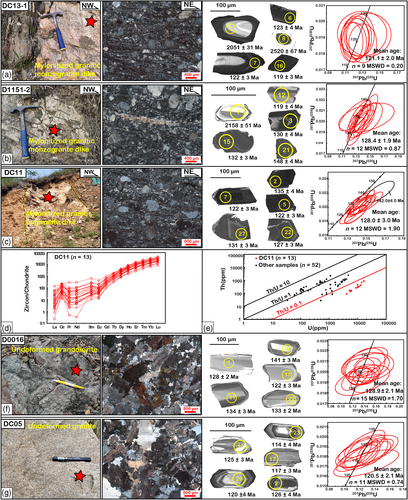
Sample D1151 was collected from a mylonitized monzogranite dike that intruded the Xiwei shear zone (Figures 2b and 6b). The CL images revealed that the zircon grains in the sample were subhedral to euhedral, and most had a core–rim structure with clear oscillatory zoning at the rim, indicating a magmatic origin (Figure 6b). Among 30 spot analyses, 22 analyses were more than 90% concordant, with Th/U ratios ranging from 0.1 to 0.2 (Figure 6e), and U–Pb ages of 119–2185 Ma. Except for some Palaeoproterozoic and Neoproterozoic inherited zircon, the younger groups of magmatic zircons, as indicated by the CL images and Th/U ratios, yielded a 206Pb/238U weighted mean age of 127.9 ± 2.2 Ma (n = 13; MSWD = 1.2; Figure 6b), interpreted as the magmatic crystallization age of the granite dike.
Sample DC11–1 was collected from a mylonitic granite pegmatite dike that intruded the Linyeshan shear zone (Figures 2b and 6c). The zircons from the sample were prismatic and small in grain size (i.e., ~100 μm). The CL images showed that most zircons in the dike had clear oscillatory zoning and dissolved as speckled or spongy on the rim, exhibiting hydrothermal alteration characteristics (Figure 6c). The trace–element characteristics indicated that the zircons in the dike had high U content, relatively low Th content, and Th/U ratios less than 0.1 (Figure 6e). The chondrite–normalized rare earth element (REE) patterns of zircons in the dike showed that the light rare earth elements (LREE) were depleted, whereas the heavy rare earth elements (HREE) were enriched gradually from Sm to Lu, with a positive Ce anomaly and a negative Eu anomaly, indicating that the magmatic zircons were modified by fluid or hydrothermal processes (Lei, Shi, & Liu, 2013; Figure 6d). Among 30 spot analyses, 13 analyses were more than 90% concordant, and yielded a weighted mean age of 128.0 ± 3.0 Ma (n = 12; MSWD = 1.9; Figure 6c), interpreted as the magmatic crystallization age of the granite pegmatite dike (Figure 6c).
Sample D0016 was collected from an undeformed granodiorite pluton near Qiaotouji that intruded the Feidong ductile shear zone (Figures 2b and 6f). The zircons from the sample were prismatic with an axial ratio of 1.5:1–3.0:1. The CL images showed that most zircons in the dike were bright and displayed wide oscillatory zoning without a core–rim structure, indicating a magmatic origin (Figure 6f). Nineteen concordant ages were obtained from 30 spot analyses, with Th/U ratios ranging from 0.9 to 2.1 (Figure 6e) and U–Pb ages of 122–141 Ma. The youngest groups of magmatic zircons yielded a weighted mean age of 128.9 ± 2.1 Ma (n = 15; MSWD = 1.7; Figure 6f), interpreted as the emplacement age of the undeformed granodiorite.
Sample DC05 was collected from an undeformed granite pluton outcrop in the southern Luji area that intruded the Feidong ductile shear zones (Figures 2b and 6g). The zircons from the sample were prismatic and euhedral, with an axial ratio of 2:1–3:1. The CL images revealed that most zircons from the pluton had clear oscillatory zoning and were without core–rim structure, indicating a magmatic origin (Figure 6g). Fifteen concordant ages were obtained from 30 spot analyses, with Th/U ratios ranging from 0.6 to 1.2 (Figure 6e) and U–Pb ages of 114–1958 Ma. Except for four captured zircons with ages of 1958, 1715, 745, and 534 Ma, the ages of the remaining 11 zircons were concentrated, yielding a weighted mean age of 120.5 ± 2.1 Ma (n = 11; MSWD = 1.7; Figure 6g), interpreted as the emplacement age of the undeformed granite pluton.
5 DISCUSSION
The TLFZ is famous for its large–scale sinistral strike–slip displacement during the Mesozoic and is often regarded as typical and representative of the East Asian continental marginal strike–slip fault system (Figure 7a). Because of the well–developed outcrops of the ductile shear zone, the Feidong area has become a classic area for studying the tectonic evolution of the TLFZ. Substantial recent research on the structural geology, geochronology, and magmatic petrology has been conducted on the Feidong Segment of the TLFZ (Han et al., 2015; Li, Cawood, et al., 2020; Li, Song, et al., 2020; Wang et al., 2015; Wang, Jiang, Zhang, Shen, & Fu, 2021; Wang, Niu, et al., 2016; Wang, Song, et al., 2016; Wang, Yang, et al., 2016; Zhu et al., 2005; Zhu et al., 2018), which, combined with this study, constrained well the Late Mesozoic tectonic evolution of the Feidong Segment of the TLFZ.
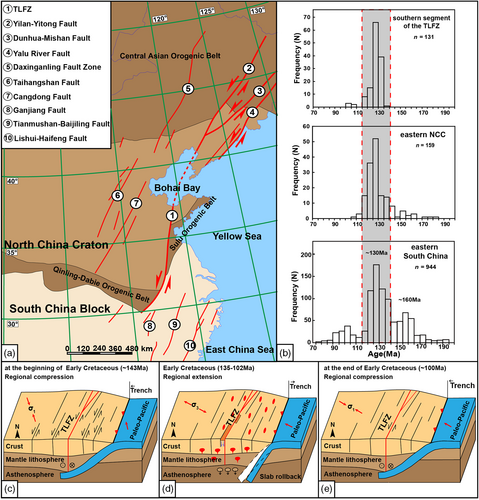
5.1 Two episodes of the sinistral strike–slip movement of the TLFZ in the Early Cretaceous
Our field and microstructural investigations of the deformational structures in the Feidong area revealed that the Feidong Segment of the TLFZ underwent two episodes of ductile deformation (D1 and D2): The D1 deformation was the major penetrative deformation, leading to the development of ductile shear zones in the Taoyuan, Xiwei, Linlinshan, and Wenjing areas; it is characterized by highly penetrative mylonitic foliation (S1), which is best expressed in Feidong metamorphic complexes. S1 dominantly dips SE at a steep angle of 60–85°, while L1 generally plunges SSW. Many criteria are available for determining the sense of shear, such as S–C fabrics, asymmetric folds, and porphyroblast systems, both in outcrops and thin sections, all of which indicate a sinistral sense of shear (Figures 4 and 5).
The previous tectono–thermal chronological studies have focused on constraining the time of the D1 deformation. The 40Ar–39Ar ages of hornblende, biotite, and whole-rock mylonite in the Feidong Segment of the TLFZ are 143, 137–124 (Zhu et al., 2005), and 120–118 (Song et al., 2003) Ma, respectively. The deformation behaviour of quartz and feldspar in the mylonite from the early ductile shear zone indicates that the D1 deformation temperature is concentrated in the 500–550 °C range. The D1 deformation temperature is equivalent to the isotopic closure temperature of hornblende which is 500 ± 50°C (Harrison, 1982), and apparently higher than the closure temperature of biotite (i.e., 300 ± 25°C; Dallmeyer & VanBreman, 1981; Harrison, Duncan, & Medougal, 1985). Furthermore, the two undeformed plutons, namely samples D0016 and DC05, intruded into the early ductile shear zones with emplacement ages of 128.9 and 120.5 Ma, respectively, which also indirectly indicates that the early sinistral strike–slip shear activity occurred before 128.9 Ma. Therefore, we interpret the plateau age of 143 Ma for hornblende as the deformation age of the Tan–Lu strike–slip motion (Zhu et al., 2005), and the other younger ages may represent the cooling ages of the D1 deformation.
After sinistral strike–slip movement at the beginning of the Early Cretaceous, the TLFZ turned into an extensional movement from the middle to the end of the Early Cretaceous, thereby inducing strong magmatic activity. During this period, a series of plutons, felsic dikes, and pegmatite dikes intruded the Feidong Complex along the NNE–striking TLFZ. Previous petrological and chronological studies of magmatic rocks indicated that magmatic activity during this period was concentrated at 135–102 Ma and peaked at 135–115 Ma in the Feidong Segment of the TLFZ (Niu et al., 2008; Shang et al., 2018; Zhu et al., 2010, 2018; Figure 7b). This suggests that the TLFZ exhibited extensional activity from the middle to the end of the Early Cretaceous. The dated plutons and dikes with ages of 129–120 Ma in this study document peak magmatic activity.
The latter ductile shear event (D2) occurred after the magmatic activity during the extensional period; associated with it was the development of latter sinistral shear zones. The early mylonitic foliation (S1) was refolded, dragged, or offset in the D2 deformation and it is clearly evident in the field (Figure 4). The D2 fabric was characterized by S2 foliation, which typically dipped SSE at a moderate angle of 30–50°. Additionally, three Early Cretaceous dikes with ages of 121.1 ± 2.0 Ma, 127.9 ± 2.2 Ma, and 128.0 ± 3.0 Ma, which cut the S1 foliation and underwent ductile deformation in the latter shear zones, are also evident in multiple places in the field (Figure 4). These ages indicate that the second sinistral strike–slip movement occurred after at least 121 Ma. A similar case was found in Xieji and Liangxiang of the Feidong area, where the sinistral strike–slip ductile shear zone developed within the granite dikes at the ages of 132 and 134 Ma, respectively (Zhu et al., 2018).
To date, there have been no reports on the exact deformation age of the latter ductile shearing. The intermediate–acid magmatism in an extensional setting in the Feidong area lasted until 102 Ma; therefore, we suggest that the latter sinistral strike–slip movement of the Feidong Segment of the TLFZ occurred at the end of the Early Cretaceous period.
5.2 Implications for the Early Cretaceous tectonic evolution of eastern China
Jurassic–Cretaceous tectonics in the eastern NCC are widely considered to have been controlled by the subduction of the Palaeo–Pacific (i.e., Izanage) Plate. Previous studies on igneous rocks, palaeomagnetism, stress field, palaeogeography, and metamorphic deformation along the margin have constrained the subduction and slab rollback history of the Palaeo–Pacific Plate since the Late Jurassic–Early Cretaceous (Chu et al., 2019, 2020; Engebretson, Cox, & Gordon, 1985; Li et al., 2014; Li, Cawood, et al., 2020; Li, Song, et al., 2020; Maruyama, Isozaki, Kimura, & Terabayashi, 1997; Zhu et al., 2018; Zhu, Jiang, et al., 2012; Zhu, Xu, et al., 2012).
In the Late Jurassic–Early Cretaceous, the Palaeo–Pacific Plate obliquely subducted beneath the East Asian continental margin in the NNW direction with low angle and high speed (Figure 7c). The angular unconformity between the Lower Cretaceous and Upper Jurassic (referred to as episode B of the Yanshan movement) was developed extensively in the NCC. The ages of volcanic rocks developed both above and below the unconformity constrained the time of the regional compressional event to be 139–138 Ma (Chen, Yan, Li, Chu, & Peng, 2013; Chen, Zhu, Jiang, & Zhang, 2013; Sun, Zhao, Wang, Gu, & Ji, 2007; Zhang et al., 2008). Meanwhile, synorogenic shortening deformation and metamorphism occurred in eastern South China under the NW–SE directional compression in the Early Cretaceous (i.e., 145–137 Ma) (Li et al., 2014; Wang & Lu, 2000; Zhang et al., 2012); this indicates that eastern China was in a regional compressional setting during the Late Jurassic–Early Cretaceous. The pre-existing NNE–striking TLFZ was resurrected and functioned in the early sinistral strike–slip motion under an NNW–SSE directional principal compressive stress.
During the Cretaceous, with the rollback of the Palaeo–Pacific Plate and the retreat of the trench, the tectonic setting shifted from compression to extension in eastern China (Figure 7d; Li et al., 2014; Zhu et al., 2018; Chu et al., 2019). Previous studies have shown that the destruction of the NCC began at 136–135 Ma, peaked at 125 Ma, and lasted until the end of the Early Cretaceous (Dai, Zheng, & Zhao, 2016; Wang, Zhou, Liu, Li, & Yang, 2018; Wu, Lin, Wilde, Zhang, & Yang, 2005; Zhu, Chen, Jiang, & Lin, 2015; Zhu, Jiang, et al., 2012; Zhu, Xu, et al., 2012). In eastern South China, extensional basins and voluminous magma intrusions and eruptions in the Early Cretaceous indicate that the region was also in an extensional setting during this period (Li et al., 2014). In this context, the TLFZ switched to normal faulting due to regional extension from the middle to the end of the Early Cretaceous (Zhu et al., 2010; Zhu, Jiang, et al., 2012; Zhu, Xu, et al., 2012). The extensional activity along the Feidong Segment of the TLFZ controlled the development of the Hefei Faulted basin (Zhu et al., 2018), induced a voluminous magma intrusion during 135–102 Ma, and eruptions of the Maotanchang and Baidafan formations in the Hefei Basin occurred in the Early Cretaceous (i.e., 130–120 Ma) (Wang, Zhu, Zhang, Liu, & Gu, 2017). The comparison of the age distribution of Mesozoic magmatic activity in the southern segment of the TLFZ, eastern NCC, and eastern South China (Dong et al., 2019; Wu et al., 2005 and references therein) suggests that their peak ages are consistent at approximately 130 Ma (Figure 7b), indicating that intense extensional activity in eastern China occurred almost simultaneously.
At the end of the Early Cretaceous, the NNW movement of the Palaeo–Pacific Plate may have accelerated again (Maruyama et al., 1997), thereby replacing high–angle with low–angle subduction (Figure 7e) and causing once again regional compression in eastern China (Zhu et al., 2018). The angular unconformity between the Upper and Lower Cretaceous (referred to as episode C of the Yanshan movement) was prevalent in the NCC (Deng, Su, Zhao, & Liu, 2004; Dong et al., 2019; Zhao et al., 2004). In eastern South China, synchronous NW–NE transpressional deformation and thrust and nappe structures have been documented in eastern South China and the Lower Yangtze region, respectively (Wang & Lu, 2000; Li et al., 2014; Wang et al., 2021). In the study area, the NW–SE regional compressional event induced an NNE–striking TLFZ with late strike–slip faulting. The intermediate–acid magmatism during 135–102 Ma in the Feidong Segment of the TLFZ also ended at the end of the Early Cretaceous because of this compressional event. Seismic profiles revealed an angular unconformity between the Lower Cretaceous Xiangdaopu Formation and the Upper Cretaceous Zhangqiao Formation in the Hefei Basin (Liu et al., 2002). Regionally, the angular unconformity between the Upper and Lower Cretaceous in the eastern NCC has been recognized by many scholars (Bing, Liu, Huang, & Zhang, 2003; Deng et al., 2004; Zhang, Dong, & Shi, 2003), while in both sides of the TLFZ, the Early Cretaceous faulted basins generally experienced uplift, inversion, and sedimentary intervals at the end of the Early Cretaceous (Zhu, Jiang, et al., 2012).
By comparison with the late Mesozoic tectonics in north-eastern China and eastern South China, it becomes apparent that the late Mesozoic evolution of the TLFZ is the epitome of the contemporaneous evolution of eastern China. This is the result of strain localization in the Cretaceous tectonic framework of eastern China.
6 CONCLUSIONS
- Field observations indicate that two periods of sinistral strike–slip movement (D1 and D2) occurred in the Feidong Segment of the TLFZ: D1 was characterized by highly penetrative mylonitic foliation (S1), which is best expressed in metamorphic complexes. S1 dominantly dips SE at a steep angle of 60–85° and L1 generally plunges SSW. However, the latter sinistral strike–slip events (D2) are formed by alternating NE–striking ductile and heterogeneous ductile deformations. Compared with S1, S2 typically dips SSE at a moderate angle of 30–50°.
- The deformation behaviour of minerals in mylonite indicates that the deformation temperatures of the early and latter sinistral strike–slip ductile shear zones are 500–550 and 400–450 °C, respectively.
- The Feidong Segment of the TLFZ had experienced strong sinistral strike–slip movement at the beginning of the Early Cretaceous (i.e., ~143 Ma), intense extensional activity during the Early Cretaceous (i.e., 135–102 Ma), and weak sinistral strike–slip at the end of the Early Cretaceous (i.e., ~100 Ma).
- Regional comparison indicates that the Early Cretaceous tectonic evolution of the TLFZ was the epitome of the tectonic evolution of eastern China; this is the result of strain localization in the Cretaceous tectonic framework of eastern China.
ACKNOWLEDGEMENTS
This research was financially supported by funds from the China Geological Survey (grant no. DD20190043), and the Public Geological Survey Program of Anhui Province (Grant No. 2016–g–1–4). We thank Dr. Yue Li, Zhenwei Li, Fang Yuan, and Yangyang Wang for their help with fieldwork and data analysis. We are grateful to the Executive Editor Prof. Sanzhong Li and two anonymous reviewers for their constructive comments.
CONFLICT OF INTEREST
The authors declare no conflicts of interest.
Open Research
DATA AVAILABILITY STATEMENT
The dataset used and support the findings of this study are available within the main body of the manuscript and the supplementary material, which are openly available in a public.



